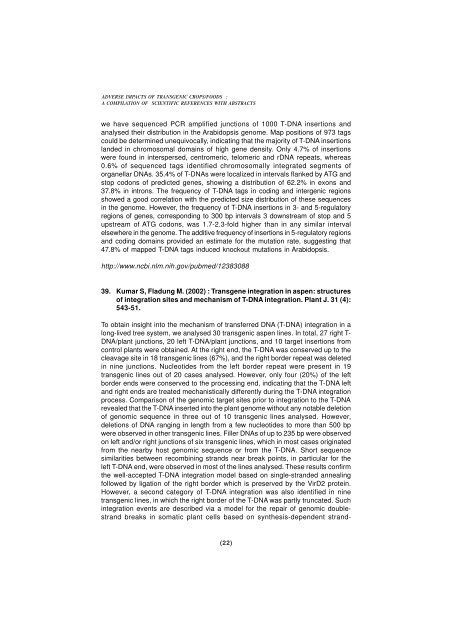omb3dyw
omb3dyw
omb3dyw
Create successful ePaper yourself
Turn your PDF publications into a flip-book with our unique Google optimized e-Paper software.
ADVERSE IMPACTS OF TRANSGENIC CROPS/FOODS :A COMPILATION OF SCIENTIFIC REFERENCES WITH ABSTRACTSwe have sequenced PCR amplified junctions of 1000 T-DNA insertions andanalysed their distribution in the Arabidopsis genome. Map positions of 973 tagscould be determined unequivocally, indicating that the majority of T-DNA insertionslanded in chromosomal domains of high gene density. Only 4.7% of insertionswere found in interspersed, centromeric, telomeric and rDNA repeats, whereas0.6% of sequenced tags identified chromosomally integrated segments oforganellar DNAs. 35.4% of T-DNAs were localized in intervals flanked by ATG andstop codons of predicted genes, showing a distribution of 62.2% in exons and37.8% in introns. The frequency of T-DNA tags in coding and intergenic regionsshowed a good correlation with the predicted size distribution of these sequencesin the genome. However, the frequency of T-DNA insertions in 3- and 5-regulatoryregions of genes, corresponding to 300 bp intervals 3 downstream of stop and 5upstream of ATG codons, was 1.7-2.3-fold higher than in any similar intervalelsewhere in the genome. The additive frequency of insertions in 5-regulatory regionsand coding domains provided an estimate for the mutation rate, suggesting that47.8% of mapped T-DNA tags induced knockout mutations in Arabidopsis.http://www.ncbi.nlm.nih.gov/pubmed/1238308839. Kumar S, Fladung M. (2002) : Transgene integration in aspen: structuresof integration sites and mechanism of T-DNA integration. Plant J. 31 (4):543-51.To obtain insight into the mechanism of transferred DNA (T-DNA) integration in along-lived tree system, we analysed 30 transgenic aspen lines. In total, 27 right T-DNA/plant junctions, 20 left T-DNA/plant junctions, and 10 target insertions fromcontrol plants were obtained. At the right end, the T-DNA was conserved up to thecleavage site in 18 transgenic lines (67%), and the right border repeat was deletedin nine junctions. Nucleotides from the left border repeat were present in 19transgenic lines out of 20 cases analysed. However, only four (20%) of the leftborder ends were conserved to the processing end, indicating that the T-DNA leftand right ends are treated mechanistically differently during the T-DNA integrationprocess. Comparison of the genomic target sites prior to integration to the T-DNArevealed that the T-DNA inserted into the plant genome without any notable deletionof genomic sequence in three out of 10 transgenic lines analysed. However,deletions of DNA ranging in length from a few nucleotides to more than 500 bpwere observed in other transgenic lines. Filler DNAs of up to 235 bp were observedon left and/or right junctions of six transgenic lines, which in most cases originatedfrom the nearby host genomic sequence or from the T-DNA. Short sequencesimilarities between recombining strands near break points, in particular for theleft T-DNA end, were observed in most of the lines analysed. These results confirmthe well-accepted T-DNA integration model based on single-stranded annealingfollowed by ligation of the right border which is preserved by the VirD2 protein.However, a second category of T-DNA integration was also identified in ninetransgenic lines, in which the right border of the T-DNA was partly truncated. Suchintegration events are described via a model for the repair of genomic doublestrandbreaks in somatic plant cells based on synthesis-dependent strand-(22)


